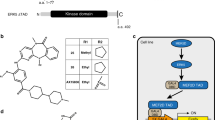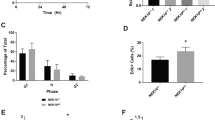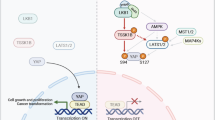Abstract
The recently identified subfamily of WNK protein kinases is characterized by a unique sequence variation in the catalytic domain and four related human WNK genes were identified. Here, we describe the cloning and functional analysis of the human family member WNK2. We show that the depletion of endogenous WNK2 expression by RNA interference in human cervical HeLa cancer cells led to the activation of the extracellular signal–regulated kinase (ERK)1/2 mitogen-activated protein kinases but, in contrast to the depletion of WNK1, had no effect on ERK5. Furthermore, expression of a kinase-dead WNK2-K207M mutant also activated ERK1/2 suggesting that WNK2 catalytic activity is required. Depletion of WNK2 expression increased G1/S progression and potentiated the cellular response to low epidermal growth factor concentrations. The molecular mechanism of ERK1/2 activation in WNK2-depleted cells lies downstream of the Raf kinases and involves MEK1 phosphorylation at serine 298 in both HeLa and HT29 colon cancer cells. This modification is linked to the upregulation of MEK1 activity toward ERK1/2. Together, these results provide evidence that WNK2 is involved in the modulation of growth factor–induced cancer cell proliferation through the MEK1/ERK1/2 pathway. The data identify WNK2 as a candidate tumor suppressor gene and suggest a coordinated activity of WNK kinases in the regulation of cell proliferation.
This is a preview of subscription content, access via your institution
Access options
Subscribe to this journal
Receive 50 print issues and online access
$259.00 per year
only $5.18 per issue
Buy this article
- Purchase on Springer Link
- Instant access to full article PDF
Prices may be subject to local taxes which are calculated during checkout





Similar content being viewed by others
Accession codes
References
Alessi DR, Saito Y, Campbell DG, Cohen P, Sithanandam G, Rapp U et al. (1994). Identification of the sites in MAP kinase kinase-1 phosphorylated by p74raf-1. EMBO J 13: 1610–1619.
Balmanno K, Cook SJ . (1999). Sustained MAP kinase activation is required for the expression of cyclin D1, p21Cip1 and a subset of AP-1 proteins in CCL39 cells. Oncogene 18: 3085–3097.
Coles LC, Shaw PE . (2002). PAK1 primes MEK1 for phosphorylation by Raf-1 kinase during cross-cascade activation of the ERK pathway. Oncogene 21: 2236–2244.
Davies H, Bignell GR, Cox C, Stephens P, Edkins S, Clegg S et al. (2002). Mutations in the BRAF gene in human cancer. Nature 417: 949–954.
Dobrowolski S, Harter M, Stacey DW . (1994). Cellular ras activity is required for passage through multiple points of the G0/G1 phase in BALB/c 3T3 cells. Mol Cell Biol 14: 5441–5449.
Ebisuya M, Kondoh K, Nishida E . (2005). The duration, magnitude and compartmentalization of ERK MAP kinase activity: mechanisms for providing signaling specificity. J Cell Sci 118: 2997–3002.
Eblen ST, Slack JK, Weber MJ, Catling AD . (2002). Rac-PAK signaling stimulates extracellular signal-regulated kinase (ERK) activation by regulating formation of MEK1-ERK complexes. Mol Cell Biol 22: 6023–6033.
Frost JA, Steen H, Shapiro P, Lewis T, Ahn N, Shaw PE et al. (1997). Cross-cascade activation of ERKs and ternary complex factors by Rho family proteins. EMBO J 16: 6426–6438.
Gagnon KB, England R, Delpire E . (2006). Characterization of SPAK and OSR1, regulatory kinases of the Na-K-2Cl cotransporter. Mol Cell Biol 26: 689–698.
Gamba G . (2005). Role of WNK kinases in regulating tubular salt and potassium transport and in the development of hypertension. Am J Physiol Renal Physiol 288: F245–F252.
Gschwind A, Fischer OM, Ullrich A . (2004). The discovery of receptor tyrosine kinases: targets for cancer therapy. Nat Rev Cancer 4: 361–370.
Hanks SK, Hunter T . (1995). The eucaryotic protein kinase superfamily: kinase (catalytic) domain structure and classification. FASEB J 9: 576–596.
Hong C, Moorefield KS, Jun P, Aldape KD, Kharbanda S, Phillips HS et al. (2007). Epigenome scans and cancer genome sequencing converge on WNK2, a kinase-independent suppressor of cell growth. Proc Natl Acad Sci USA 104: 10974–10979.
Ito M, Shichijo S, Tsuda N, Ochi M, Harashima N, Saito N et al. (2001). Molecular basis of T cell-mediated recognition of pancreatic cancer cells. Cancer Res 61: 2038–2046.
Jiang ZY, Zhou QL, Holik J, Patel S, Leszyk J, Coleman K et al. (2005). Identification of WNK1 as a substrate of Akt/protein kinase B and a negative regulator of insulin-stimulated mitogenesis in 3T3-L1 cells. J Biol Chem 280: 21622–21628.
Kahle KT, Wilson FH, Lalioti M, Toka H, Qin H, Lifton RP . (2004). WNK kinases: molecular regulators of integrated epithelial ion transport. Curr Opin Nephrol Hypertens 13: 557–562.
Kerkhoff E, Rapp UR . (1998). High-intensity Raf signals convert mitotic cell cycling into cellular growth. Cancer Res 58: 1636–1640.
Kostich M, English J, Madison V, Gheyas F, Wang L, Qiu P et al. (2002). Human members of the eukaryotic protein kinase family. Genome Biol 3: RESEARCH0043.
Lee BH, Min X, Heise CJ, Xu BE, Chen S, Shu H et al. (2004). WNK1 phosphorylates synaptotagmin 2 and modulates its membrane binding. Mol Cell 15: 741–751.
Lenertz LY, Lee BH, Min X, Xu BE, Wedin K, Earnest S et al. (2005). Properties of WNK1 and implications for other family members. J Biol Chem 280: 26653–26658.
Li W, Han M, Guan KL . (2000). The leucine-rich repeat protein SUR-8 enhances MAP kinase activation and forms a complex with Ras and Raf. Genes Dev 14: 895–900.
Manning G, Whyte DB, Martinez R, Hunter T, Sudarsanam S . (2002). The protein kinase complement of the human genome. Science 298: 1912–1934.
Marshall CJ . (1995). Specificity of receptor tyrosine kinase signalling: transient versus sustained extracellular signal-regulated kinase activation. Cell 80: 179–185.
Matheny SA, Chen C, Kortum RL, Razidlo GL, Lewis RE, White MA . (2004). Ras regulates assembly of mitogenic signalling complexes through the effector protein IMP. Nature 427: 256–260.
Matos P, Jordan P . (2005). Expression of Rac1b stimulates NF-κB-mediated cell survival and G1/S-progression. Exp Cell Res 305: 292–299.
Min X, Lee BH, Cobb MH, Goldsmith EJ . (2004). Crystal structure of the kinase domain of WNK1, a kinase that causes a hereditary form of hypertension. Structure 12: 1303–1311.
Moriguchi T, Urushiyama S, Hisamoto N, Iemura S, Uchida S, Natsume T et al. (2005). WNK1 regulates phosphorylation of cation-chloride-coupled cotransporters via the STE20-related kinases, SPAK and OSR1. J Biol Chem 280: 42685–42693.
Morrison DK, Davis RJ . (2003). Regulation of MAP kinase signalling modules by scaffold proteins in mammals. Annu Rev Cell Dev Biol 19: 91–118.
Murphy LO, MacKeigan JP, Blenis J . (2004). A network of immediate early gene products propagates subtle differences in mitogen-activated protein kinase signal amplitude and duration. Mol Cell Biol 24: 144–153.
Park ER, Eblen ST, Catling AD . (2007). MEK1 activation by PAK: a novel mechanism. Cell Signal 19: 1488–1496.
Rodriguez-Viciana P, Tetsu O, Oda K, Okada J, Rauen K, McCormick F . (2005). Cancer targets in the Ras pathway. Cold Spring Harb Symp Quant Biol 70: 461–467.
Scanlan MJ, Chen YT, Williamson B, Gure AO, Stockert E, Gordan JD et al. (1998). Characterization of human colon cancer antigens recognized by autologous antibodies. Int J Cancer 76: 652–658.
Sebolt-Leopold JS, Herrera R . (2004). Targeting the mitogen-activated protein kinase cascade to treat cancer. Nat Rev Cancer 4: 937–947.
Sewing A, Wiseman B, Lloyd AC, Land H . (1997). High-intensity Raf signal causes cell cycle arrest mediated by p21Cip1. Mol Cell Biol 17: 5588–5597.
Slack-Davis JK, Eblen ST, Zecevic M, Boerner SA, Tarcsafalvi A, Diaz HB et al. (2003). PAK1 phosphorylation of MEK1 regulates fibronectin-stimulated MAPK activation. J Cell Biol 162: 281–291.
Veríssimo F, Jordan P . (2001). WNK kinases, a novel protein kinase subfamily in multi-cellular organisms. Oncogene 20: 5562–5569.
Veríssimo F, Silva E, Morris JD, Pepperkok R, Jordan P . (2006). Protein kinase WNK3 increases cell survival in a caspase 3-dependent pathway. Oncogene 25: 4172–4182.
Vitari AC, Deak M, Collins BJ, Morrice N, Prescott AR, Phelan A et al. (2004). WNK1, the kinase mutated in an inherited high-blood-pressure syndrome, is a novel PKB (protein kinase B)/Akt substrate. Biochem J 378: 257–268.
Vitari AC, Deak M, Morrice NA, Alessi DR . (2005). The WNK1 and WNK4 protein kinases that are mutated in Gordon's hypertension syndrome phosphorylate and activate SPAK and OSR1 protein kinases. Biochem J 391: 17–24.
Wellbrock C, Karasarides M, Marais R . (2004). The RAF proteins take centre stage. Nat Rev Mol Cell Biol 5: 875–885.
Wilson FH, Disse-Nicodeme S, Choate KA, Ishikawa K, Nelson-Williams C, Desitter I et al. (2001). Human hypertension caused by mutations in WNK kinases. Science 293: 1107–1112.
Woods D, Parry D, Cherwinski H, Bosch E, Lees E, McMahon M . (1997). Raf-induced proliferation or cell cycle arrest is determined by the level of Raf activity with arrest mediated by p21Cip1. Mol Cell Biol 17: 5598–5611.
Xu BE, English JM, Wilsbacher JL, Stippec S, Goldsmith EJ, Cobb MH . (2000). WNK1, a novel mammalian serine/threonine protein kinase lacking the catalytic lysine in subdomain II. J Biol Chem 275: 16795–16801.
Xu BE, Stippec S, Chu PY, Lazrak A, Li XJ, Lee BH et al. (2005). WNK1 activates SGK1 to regulate the epithelial sodium channel. Proc Natl Acad Sci USA 102: 10315–10320.
Xu BE, Stippec S, Lenertz L, Lee B-H, Zhang W, Lee YK et al. (2004). WNK1 activates ERK5 by an MEKK2/3-dependent mechanism. J Biol Chem 279: 7826–7831.
Zheng CF, Guan KL . (1994). Activation of MEK family kinases requires phosphorylation of two conserved Ser/Thr residues. EMBO J 13: 1123–1131.
Acknowledgements
We thank Estelle Le Gall for her contribution in the Differential Display analysis, Sónia Pedro for running the automated ABI sequencer and Jonathan Morris (London) and Carla Oliveira (Porto) for providing plasmids used in this study. This work was supported by INSERM and the Portuguese Fundação para a Ciência e Tecnologia (grant POCI/56294/04, Programa de Financiamento Plurianual do CIGMH and fellowship BD 11180/02 to SM) as well as a FEBS short-term visitor fellowship to SM.
Author information
Authors and Affiliations
Corresponding author
Additional information
Supplementary Information accompanies the paper on the Oncogene website (http://www.nature.com/onc).
Supplementary information
Rights and permissions
About this article
Cite this article
Moniz, S., Veríssimo, F., Matos, P. et al. Protein kinase WNK2 inhibits cell proliferation by negatively modulating the activation of MEK1/ERK1/2. Oncogene 26, 6071–6081 (2007). https://doi.org/10.1038/sj.onc.1210706
Received:
Revised:
Accepted:
Published:
Issue Date:
DOI: https://doi.org/10.1038/sj.onc.1210706
Keywords
This article is cited by
-
Somatic mutations in single human cardiomyocytes reveal age-associated DNA damage and widespread oxidative genotoxicity
Nature Aging (2022)
-
An update regarding the role of WNK kinases in cancer
Cell Death & Disease (2022)
-
Circ_0001666 affects miR-620/WNK2 axis to inhibit breast cancer progression
Genes & Genomics (2021)
-
LINC00858 knockdown inhibits gastric cancer cell growth and induces apoptosis through reducing WNK2 promoter methylation
Cellular Oncology (2020)
-
Long non-coding RNA LINC00858 exerts a tumor-promoting role in colon cancer via HNF4α and WNK2 regulation
Cellular Oncology (2020)



